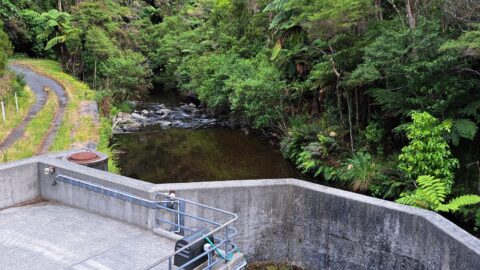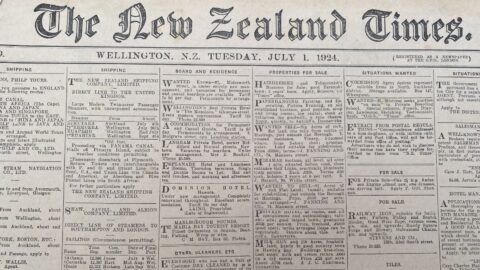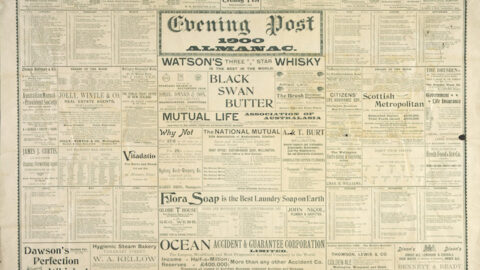THE WAINUIOMATA WATERWORKS
The temporary stoppage of the water through the box fluming lately erected by Mr Joseph Saunders, occasioned by a slight accident to the dam which had been constructed at the head of the fluming, ceased on Saturday afternoon last, and at about 3 o’clock the water again flowed through the boxes. In less than half an hour, it had risen to a good head of about 14 inches, with an upward tendency. The water, after it had run for about ten minutes, was perfectly clear and sweet, so that now there need be no apprehension as to its quality.
Of course, for some few minutes after the water commenced to flow, a quantity of debris, consisting of scum, pieces of wood, and a few trout, passed through the boxes, but this would enter the well near Sinclair’s old sawmills, where it would be precipitated. It may be safely asserted that now there need be no further fear of a repetition of the late water famine.
The work in connection with the fluming, although, of course, only intended as a temporary structure, is faithfully constructed and would, doubtless, should occasion require it, last for a considerable time. The boxes are built of 2-inch white pine, measuring 2 feet by 2 feet, and are about a quarter of a mile in length, being carried across to the watershed on trestles.
Judging from the progress made in the old contract, it will take about five or six weeks before the work will be concluded. Mr Saunders assured our representative, who visited the works on Saturday, that he would most assuredly complete the undertaking within the contract time. The work, when entered upon by the present contractor, was surrounded by no ordinary difficulties, and these have been considerably increased by the recent heavy rains.
The contract had to be entered upon with vigour, and it is due to the contractor to say that it has been carried out through a combination of capital and energy. The apron wall, it will be recollected, so far as the centre of it was concerned, had been broken down, and a clean breach had been made by a heavy downpour of rain just at the time it required solidifying.
It is needless to again revert to the character of the work, especially with regard to the quality of the cement used in the wall during the contract, and it is sufficient to say that a very large quantity of debris had to be cleared away by the present contractor after the disaster. Not only, however, was this portion of the work satisfactorily accomplished, but the workmen had to go right down to the solid rock before they could recommence the work.
In fact, numberless difficulties presented themselves along the way, but they were finally overcome. Abandoning the proposition of employing a Californian pump, the contractor placed a powerful centrifugal engine in the bed of the stream for the purpose of pumping out the water which had not only lodged there but also percolated through the loose gravel. Gangs of men were kept working day and night for four weeks, and at length, the rock was reached, and the water was under control.
This enabled the men to set their concrete foundations, which was, after many anxious hours, successfully accomplished by Mr Whiting, the overseer of the works. The contract, which was undertaken at a very critical juncture of the season, may now be said to be an accomplished fact.
Bit by bit, the wall grew until now it is completed, and scarcely anything remains to be done, except for removing the wooden casing. This operation was effected on Tuesday, by which time it was anticipated that the concrete would be quite hard and set.
Other important work, however, remains to be undertaken before the contract is fully completed. The apron wall, it may be explained to those unfamiliar with such matters, is not by any means the main dam. Through and beneath it, overflow iron pipes are placed. These are being laid along the gulch, which, before the recent disaster, was a narrow neck of land.
Workmen are currently engaged in excavating the ground to the proper level, and as this is done, overflow pipes are being laid, with a strong concrete covering over them. This will, in turn, be filled in, sealing the pipes to a depth of thirty-two feet. The purpose of this concrete tunnel, or covering for the overflow pipes, may at first seem unnecessary, but such is not the case.
These pipes will not, except in cases of extreme overflow, be surcharged, and consequently, they will corrode. As they deteriorate, the concrete subwater channel will take their place. Fifty-one pipes will be used in this overflow system.
The main service, it should be noted, is not affected in the least by the recent breach of the apron wall. As soon as the apron wall and the overflow wall are repaired, the water can be diverted from the fluming boxes into the correct and permanent channel.
The contractor is now concentrating his workforce on the overflow dam. The very best materials and workmanship are being used for this part of the project. The gravel is thoroughly washed, and not a particle of clay is permitted to adhere to the finely sifted gravel, which is combined with a generous amount of cement.
At present, the site is a hive of activity, with no fewer than thirty to forty men employed. Citizens may be reassured that, within a few weeks, the Wainuiomata water scheme will be an accomplished reality—one that can be expected to last for the next hundred years.
Tags: Newspaper Sinclair Waterworks





